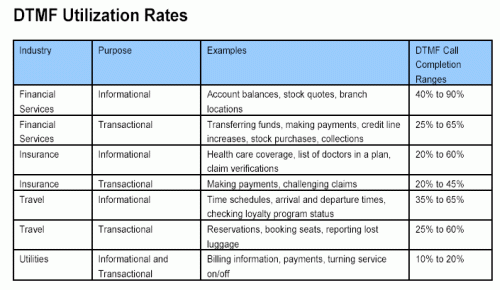
 Customers choose to do business with companies that provide the products and services they need and deliver an outstanding experience. Customers expect excellent service and will quickly abandon a business relationship when service quality does not live up to their expectations, even when the products are adequate. Companies must find ways to satisfy increasingly demanding customers while decreasing their own operating costs and improving profit margins. Speech recognition is the most compelling form of self-service for companies large and small because its satisfying for customers and cost effective for enterprises.
Customers choose to do business with companies that provide the products and services they need and deliver an outstanding experience. Customers expect excellent service and will quickly abandon a business relationship when service quality does not live up to their expectations, even when the products are adequate. Companies must find ways to satisfy increasingly demanding customers while decreasing their own operating costs and improving profit margins. Speech recognition is the most compelling form of self-service for companies large and small because its satisfying for customers and cost effective for enterprises.
A well-designed speech application gives customers the information they want, the way they want, when they want it. It doesnt require customers to wait for their PC to boot or to navigate a web site in the hope of finding answers.
It doesnt force customers to remember and enter numbers into their touch-tone phone to obtain only a portion of the required information. Nor does it force callers to repeatedly hang up and start over, a common occurrence in many Interactive Voice Response (IVR) environments. A well-tuned speech recognition application anticipates questions and provides accurate answers in a user-friendly manner that promotes a positive customer experience.
The economic slowdown has accelerated the need to automate a larger percentage of service requests. With few exceptions, companies can no longer afford to provide live assistance to all callers; its simply too expensive. According to Gartner Group, a typical service call costs $5.50, as compared to $0.45 for a call handled by an IVR. Companies that use speech recognition will improve service quality and enhance the customer experience while reducing costs, giving them a distinct competitive advantage.
With so much pressure on enterprises to provide great service at a competitive price, speech recognition is essential for all industries: financial services, airlines, government, public sector, non-profit, retail, utilities, health care, pharmaceutical, insurance, outsourcing, telecom and others. Worldwide investments in speech recognition were $695 million in 2002 and are expected to grow to $1.4 billion by the end of 2004, according to Datamonitor.
The technology is proven and best practices so well established that the downside risk is minimal and the potential payback is great, typically yielding a positive Return on Investment (ROI) in six to 12 months.
Speech recognition benefits
Speech recognition has traditionally been viewed as a contact centre productivity tool for service organizations because that is where the financial payback has been the greatest. But the technology has already proven effective in improving productivity and generating revenue outside of contact centres, when used throughout the enterprise. On the productivity side, speech recognition yields the following benefits:
> Reduces calls to live agents,
> Shortens call lengths,
> Reduces call hold times, and
> Decreases call abandonment rates
Speech technology is being used to increase revenue by automating activities that previously required agent assistance, such as a credit line increase or cross-selling a related service, and by providing new services, including voice portals, voice activated dialling and e-mail reading.
For both enterprises and their customers, the financial benefits of a properly implemented speech recognition system are huge whether a speech system is new or added to an existing IVR application. Dreyfus, a financial institution that receives 12,000 calls per day, increased its IVR self-service usage rate from 45 per cent to 63 per cent and saved an additional $1 million/year by adding speech to its existing IVR platform.
Customers prefer speech recognition to other forms of self-service automation because it requires nothing more than talking, and the access device, the telephone, is so ubiquitous. Because customers are willing to use speech applications, the payback can be as short as six months and is generally no longer than 12 months.
The benefits of speech self-service extend far beyond the measurable financials that are required to obtain investment approval. Enterprises that implement speech systems should expect to see improvements in employee satisfaction, as agent burnout and turnover decrease and repetitive inquiries are offloaded to automated systems. Companies will also see an improvement in customer satisfaction, particularly if the company has speech-enabled a touch-tone based IVR application.
What is ROI?
ROI is a group of measures used to determine the financial impact of an investment. The three most common ROI measures are:
> Payback period the number of months or years it takes for a project to earn back its initial investment;
> Net Present Value (NPV) the sum of all project costs and benefits expressed in the value of todays dollar / euro; and
> Internal Rate of Return (IRR) a measure of how much an investment is earning, expressed as a percentage.
Most organizations have ROI guidelines incorporating some or all of these measures and present financial approval thresholds that are issued annually by the office of the CFO. Its important to obtain and use these guidelines, as they explain what it takes to get approval for a project and will save managers a great deal of time and effort.
Speech recognition Return on Investment
Technology investments that improve productivity and have an ROI payback of 12 months or less are being approved in many organizations, even during tough economic times. Investments in speech recognition applications can be justified because their benefits are readily quantifiable. In order to track and report the success of any project, its always a good idea to benchmark an operating area or function prior to making an investment.
Speech recognition justification criteria
Technology investments must be justified based on hard and quantifiable benefits, as these are the only measures acceptable to Chief Financial Officers (CFOs) today. However, the technology selection decision should reflect both hard and soft benefits, as both are relevant to the departments performance. Cost centres can justify speech investments on:
> Productivity improvement reduction in agents, supervisors, trainers, QA specialists
> Cost reduction reducing the number of calls, agent talk time, line charges (from reduced agent talk time and hold time), hiring and training costs
> Cost avoidance eliminating the need to purchase additional hardware or software to handle incremental calls
Profit centres can also include incremental revenue in their ROI analyses, even though CFOs will not accept soft benefits, as they cant be easily quantified or attributed to a particular investment. Speech recognition soft benefits that an enterprise should still evaluate during the selection process include:
> Reduction in the number of abandoned calls
> Reduction in customer call backs
> Reduction in call centre hardware and software
> Reduction in agent attrition
> Increase in customer satisfaction
> Increase in customer loyalty
> Increase in revenue
Industry metrics
To accurately calculate the payback from a speech application, the following metrics must be known:
> Average call length
> Average talk time of the DTMF IVR
> Average talk time of the speech IVR
> Average hold time for agent calls
> Toll free cost/minute
> Cost per agent-handled calls
If these numbers are not readily available from the existing system reports of an Automatic Call Distributor (ACD), IVR or telecom provider, its suggested that enterprises use numbers from industry analyst firms such as Gartner Group, Forrester Research or Datamonitor, for example.
Industry variability
When calculating a ROI, it is advisable to use conservative estimates for cost savings, operating expenses and depreciation to ensure that commitments can be met. This ROI analysis is based on a three-year depreciation schedule, the generally accepted time frame for technology investments, but its not uncommon for companies to depreciate equipment over a five-year period.

While the technology in this model is depreciated quickly, most touch-tone and speech systems are maintained for at least five years, so the net present value and internal rate of return will be even greater than what is reflected in the model.
The cost per DTMF IVR transaction varies greatly between companies, depending on the usage rate of the system. Gartner Group estimates the average cost per IVR transaction to be $0.45, however high-volume users have reported rates of less than $0.10 per transaction and companies that are not using their DTMF system effectively can realize costs as great as $1.00/transaction.
DTMF usage rates are impacted by the quality and ease of use of the script, system purpose (informational vs. transactional), system functionality, customers experience, and willingness of customers to use the IVR.
Speech recognition projected utilization guidelines
The results of speech recognition implementations will vary based on many criteria, including application relevancy, application design and interface, business complexity, customer base and how well the application is communicated and maintained. There are general guidelines, however, for projecting the usage rates.
Projected speech recognition usage guidelines
If the touch-tone IVR usage rate is below 20 per cent, then 1) touch-tone IVR is not an appropriate application for this customer base, or 2) the system does not provide the functionality required by its customers, or 3) the system is poorly designed or communicated.
When there is a mismatch between system capabilities and the implementation, the potential benefits from adding speech capabilities are generally greater than in organizations that have done a better job of leveraging the use of touch-tone IVR.

When considering the use of speech recognition technology in environments where touch-tone IVR has not previously been well received and the usage rates are below 20 per cent, its essential to first determine if speech is going to be received any better. If speech is a good self-service interface for the customer base, enterprises can expect to see their overall IVR system utilization rates increase in the 36 per cent to 50 per cent range and an overall increase of 80 per cent to 150 per cent within the first 18 months.
Where touch-tone IVR has previously been well received and a large percentage of the customer base was already using it for self-service, the incremental benefit of adding speech is likely to be approximately 10 per cent to 30 per cent above the existing usage rates. Both scenarios yield a quick payback of six to 12 months.
Conclusion
Much has been written about the growth expectations of speech recognition technology. Analysts in many firms, including Gartner Group, DataQuest, IDC, Datamonitor, Giga Information Group and Frost & Sullivan, agree that speech recognition is set to grow rapidly during the next three to five years, realizing a compounded annual growth rate of anywhere from 25 per cent to 50 per cent.
The primary reason why this technology is expected to be one of the top market performers is that speech is the most ubiquitous form of communication in and out of the US, making speech recognition the most preferred form of self-service.
To remain competitive, enterprises of all sizes must improve their profit margins and decrease their operating expenses. The economy has exacerbated an already tough operating environment and is pushing companies to optimise the financial returns from their limited technology investment dollars / euros.
There is no sure thing in the technology world, but with the enhancements in speech recognition best practices, the substantial improvements in the technology, and its ease of use, this is about as good as it gets. In the majority of situations, speech recognition will yield a positive return to the investing company in less than one year and improve customer satisfaction.
Donna Fluss
[email protected]
2003-09-15
To check out the full report, please click here
Em Foco – Opinião
Consultoria – Advice

